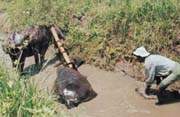| Plus |
|
|||||
|
Villagers in,
jumbos out The increasing man-elephant conflict is mainly due to people encroaching on to the elephants' habitat without considering the ecological needs of the elephants. Struggling to survive in the face of the increasing cost of living, villagers clear jungle areas for cultivation. Many of these clearings are situated in the habitual paths used by elephants and hence the conflict.
A study done by Ravindra Corea, who established this project, revealed that around 70% of the elephants in Sri Lanka roam outside the protected areas (PAs). The project is based on the concept of fencing the elephants out from the villages and fields, rather than fencing them into restricted areas, thus leaving them free to roam outside the protected areas. Local Project Officer Chandeep Corea explained that Ravi Corea, based in New York originally conducted a study of elephants in 1996. He thought the best way to protect the elephants was to put up small fences around the villages. During a subsequent visit in 1998, the village of Gamburu Oya/Pusseleyaya was highlighted as having the highest incidence of human and elephant deaths and destruction. "The villagers were so upset they were trying to block vehicles coming to the Wasgomuwa Park," Chandeep said. "The Wild Life Department could not do much due to lack of funds. We spoke to the Park Warden and he suggested we do something for this village. So the first project was set up there." The funds are raised by Sri Lankan Americans, who have formed the Sri Lanka Wildlife Conservation Society, a tax free body in the US. The US Fish and Wildlife and Disney Wildlife Fund also contributed towards the fund.
The first project, which began in 1998, was the construction of an eight km solar powered fence around the Gamburuoya/Pusseliyaya village close to Wasgomuwa Wildlife Park. A socio-economic survey was first done to find out how the conflict affected the villagers economically and their expenditure on crop protection. They also had discussions with the villagers and the priest in the village temple. The villagers were briefed about their responsibilities in providing the manpower for the erection of the fence and in its maintenance after completion and they agreed to cooperate. An agreement was signed by the village leaders and Farmers Association. All the required materials were provided by the project management, with the fence costing a total of US $ 54,000. The villages scattered around the Wasgomuwa park area are populated mainly by farmer families who have been given land to cultivate. However, the farmers are unable to enjoy the benefit of their labours because of the heavy crop damage by elephants. A watch hut on a tree is seen in every field.
Several elephants too have been killed while raiding the crops. "Since the 1970s the farmers in the area have suffered from elephant attacks," said Mattagamuwa Gunananda Himi, the priest in the village temple. "Every day, by 5 p.m the elephants would gather outside the village. By nightfall, they entered, destroying homes and crops, knocking down trees. The farmers regularly lost 50% of their crop." The villagers had gone in protest to the Wilgamuwa Divisional Secretariat. They were given 250 crackers and asked to form groups and guard the road against the elephants. "Following another attack on a house by an elephant, the Park Warden brought Ravi Corea with his proposal for the electric fence,"Gunananda Himi said. Groups were set up to work on the fences and the work was distributed. "There was a complete change after the fence was erected," Gunananda Himi said. "Now the villagers are able to reap their harvests. But after the fence was erected and their problems with the elephants eased, the villagers have neglected their responsibilities in maintaining the fence. A survey conducted by SLWCS showed that income levels and standards of living have increased in Pusseleyaya/Gamburuoya. It was also found that until the fence was built a village household spent an average of Rs. 5,400 annually on kerosene oil, firecrackers, torch batteries and bulbs to protect their crops from elephants. After the fence was built the annual cost per household to maintain the fence dropped to Rs. 128. "We had many problems with elephants," said A.G. Siriya, a farmer from Gamburuoya. "My house was broken three times. I had to spend about Rs.3000 on repairs each time. We used to lose more than half of our crop from the paddy field. After the fence was put up we have had no problems." Siriya said each farmer has to maintain three fence posts keeping the ground around them clear. According to him most of the farmers do attend to their fence posts. Those who neglect their work are fined Rs. 250 by the Village Society. "From the time we start cultivating the fields, until the harvest is gathered, I have to be there to protect it from elephant attack," said H.M. Suriyadasa, of Weheragalgama Village, who had gathered with other farmers to work on the new fence project around their village. According to Chandeep, after the first fence was completed, crop raiding in the village has ceased except for a few incidents where elephants have entered the village because of the negligence of the villagers. They have had requests from several other villages for electric fences and a further sum of US $ 55,000 was raised for a fence in the neighbouring village. Weheragalgama, which also has a high incidence of HEC was selected for the next project. "Our problems with the elephants have been endless," said Weheragalgama villager, M.D. Jayasena. "My house was broken into three times. Even after my paddy has been harvested, they break into the house and get at the stored paddy. We have to have a lamp lit all night. We need a bottle of oil every two days." At Weheragalgama, the villagers have begun clearing the land for the fence and building the control room. Sunpower Systems (Pvt.) Ltd., the contractors for the electric fence were also present to speak to the villagers and start on the work. Ravi Weerasekera, Chief Executive Officer (CEO) of the company said they represent a New Zealand firm, Gallaher who had invented the electric fence way back in the 1930s. It was used mainly for the dairy industry. They are also used in countries such as Africa. In Sri Lanka too, about 700 meters of electric fencing has been erected for elephant control by the Wild Life Conservation Department and the Mahaweli authorities. "We set up the control room and the first few kilometers of the fence," Ravi Weersekera said. "While in Africa, the elephants can be stopped by a two wire fence, the Sri Lankan elephants pushes the post and gets through the fence. These fences have three wires as well as a guard wire around the post for additional protection." Batteries charged by solar power are used to activate the fence. The new fence being erected at Weheragalgama will be the first one in the country with special aluminium coated wire with low resistance and a more effective shock. However, he said there is no danger to humans or elephants apart from the shock as it is a different current, a pulse with an interval between. It gives a shock but the victim does not get stuck to it. It also has a special feature, which triggers a loud siren alarm. |
||||||
Copyright © 2001 Wijeya Newspapers
Ltd. All rights reserved. |

